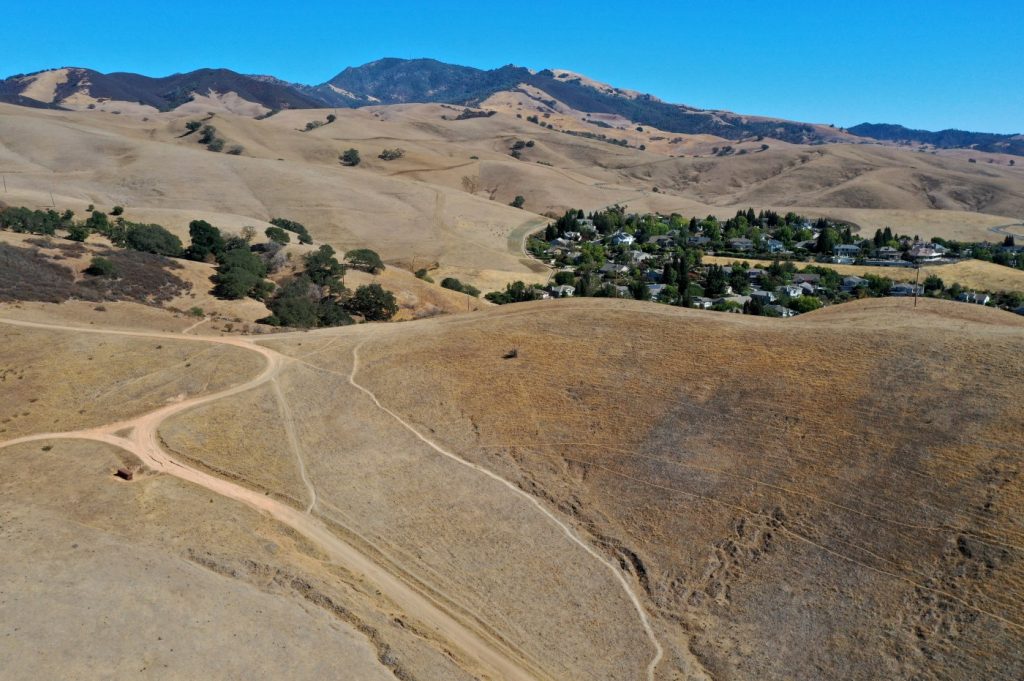Walnut Creek has scrapped plans for a controversial two-mile “flow trail” for mountain bikers atop Lime Ridge, citing city staff’s decision to prioritize larger recreation projects already underway.
Public Works Manager Mike Vickers pointed to the “extraordinary” amount of time and energy needed for ongoing capital improvement plans in the coming years, which received a boost in funding after voters approved Measure O in 2022. That project list includes a $77 million overhaul of Heather Farm Park’s pools and community center, renovations of the city’s Boundary Oak Golf Course driving range, ball field light installation at Tice Valley Park and turf replacement at Heather Farm Park’s sports fields.
Nearly five years ago, Walnut Creek began discussing ways to address the rapid expansion of unauthorized trails and prevent destruction of sensitive plants and erosion at Lime Ridge — a 1,200-acre swath of land on the eastern edge of the city.
But while bikers make up 40 to 50% of the open space users, Vickers said rouge trail issues are no longer critical — thanks to rangers’ efforts to build relationships with and educate bicyclists about trail etiquette.
“Today, many of those trails have been restored, and the open space is in much better condition than it has been historically,” Vickers said June 3, abruptly sharing the news in the final minutes of the city’s Parks Recreation Open Space Committee (PROS) meeting. “We are going to be focusing our efforts on those larger projects and devoting less time to discretionary projects.”
Staff pulled the plug on the flow trail before starting the certification process, but the project’s initial assessment, conceptual design and preliminary analysis of environmental impacts were completed. Vickers was adamant that the decision was not tied to concerns about harming the ridge’s habitat, despite comments from neighbors and the state’s Department of Fish and Wildlife.
“We don’t get this far without working with city attorneys,” Vickers said Wednesday. “If this project was in violation of any one of the documents out there, we wouldn’t move forward.”
But the decision has made some residents of the Rancho Paraiso community just south of Lime Ridge feel vindicated, as they had argued in 2021 the city did not sufficiently study the trail’s potential negative impacts on the surrounding environment and neighborhood.
Resident Valerie Gardner led the charge against the trail and accused the city of catering to mountain bikers. She and other opponents feared the trail would exacerbate traffic and parking problems on their streets by drawing even more mountain bikers to the open space, which had surged in popularity during the pandemic. Residents launched online petitions that claimed the trail would allow cyclists to convert Lime Ridge from a peaceful haven with 25 miles of walking trails to a biking hotspot — collecting roughly 2,800 signatures for both petitions.
“They were going to build jumps and berms and switchbacks, none of which is natural,” Gardner said on Wednesday, describing the design as a man-made “thrill ride” for mountain bikes. “I don’t know how you say that has no effect on the environment — it’s a bit nonsensical.”
Gardner argues that Lime Ridge was meant to be preserved as part of the total 2,700 acres of city-owned parks, open space, and trail easements — sparked by a 1974 bond measure voters approved to combat development rapidly spreading into the Mount Diablo foothills. She said bicyclists in favor of the trail were asking for more than their fair share of access, comparing the city’s flow trail plan to a parent rewarding a misbehaving child by giving them a toy.
“I think people try to label and bully by using the word ‘NIMBY,’ like it’s some curse word, but no, I don’t want that in my backyard — I don’t want it in anybody’s backyard, if it’s a protected open space,” Gardner said. “I’ve enjoyed the view of these hills for 30 years, and I don’t want to see them ruined by people that have shown such a careless disregard for their preservation.”
She stood by her claims that the city’s environmental planning documents were “found lacking on numerous counts and by numerous sources” and “the city’s arrogance in attempting to ignore environmental impacts led to the cancellation of the project.”
However, Vickers swiftly denied those allegations.
“What’s ironic about (neighbors’ push to preserve that land) is it’s the city’s responsibility to ‘save’ Lime Ridge,” he said. “We’re trying to figure out all the pieces to the puzzle to try and satisfy all users’ needs while keeping the environment at the top. I stand behind every aspect of this project.”
Vickers confirmed that no other flow trails are being currently being proposed for Walnut Creek.
Instead, he said planning staff will continue making progress on the other 16 recommendations trail committee members published in 2020 to guide management of the city’s open space. That list ranges from expanding the number of informative signs and kiosks along trails, to closing unauthorized paths that are potentially dangerous, and destructive.
Brendan Moran, PROS chair, thanked Vickers and city staff for all their efforts to propel the project forward, despite its premature demise.
“I know you put a lot of time in dealing with a lot of different stakeholders, and maybe down the road it can be revisited, maybe not,” Moran said June 3. “But the city’s got a lot of work to do, clearly, and so do you and your staff.”


